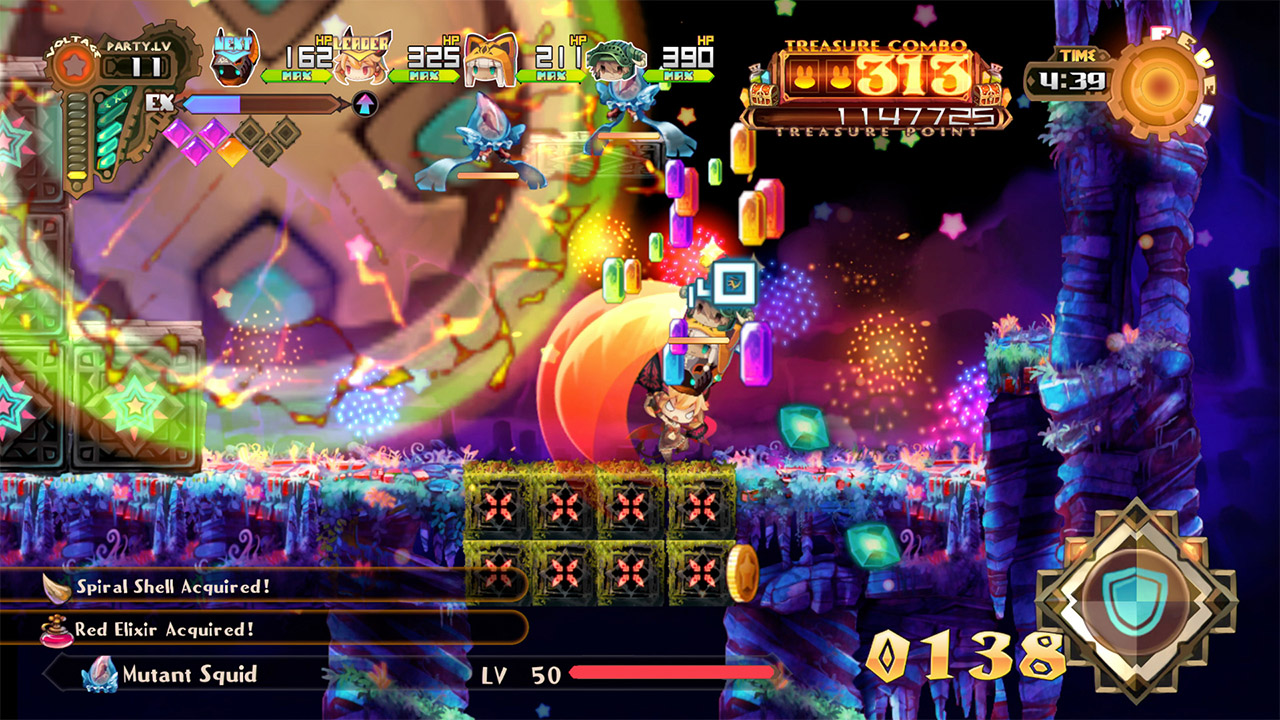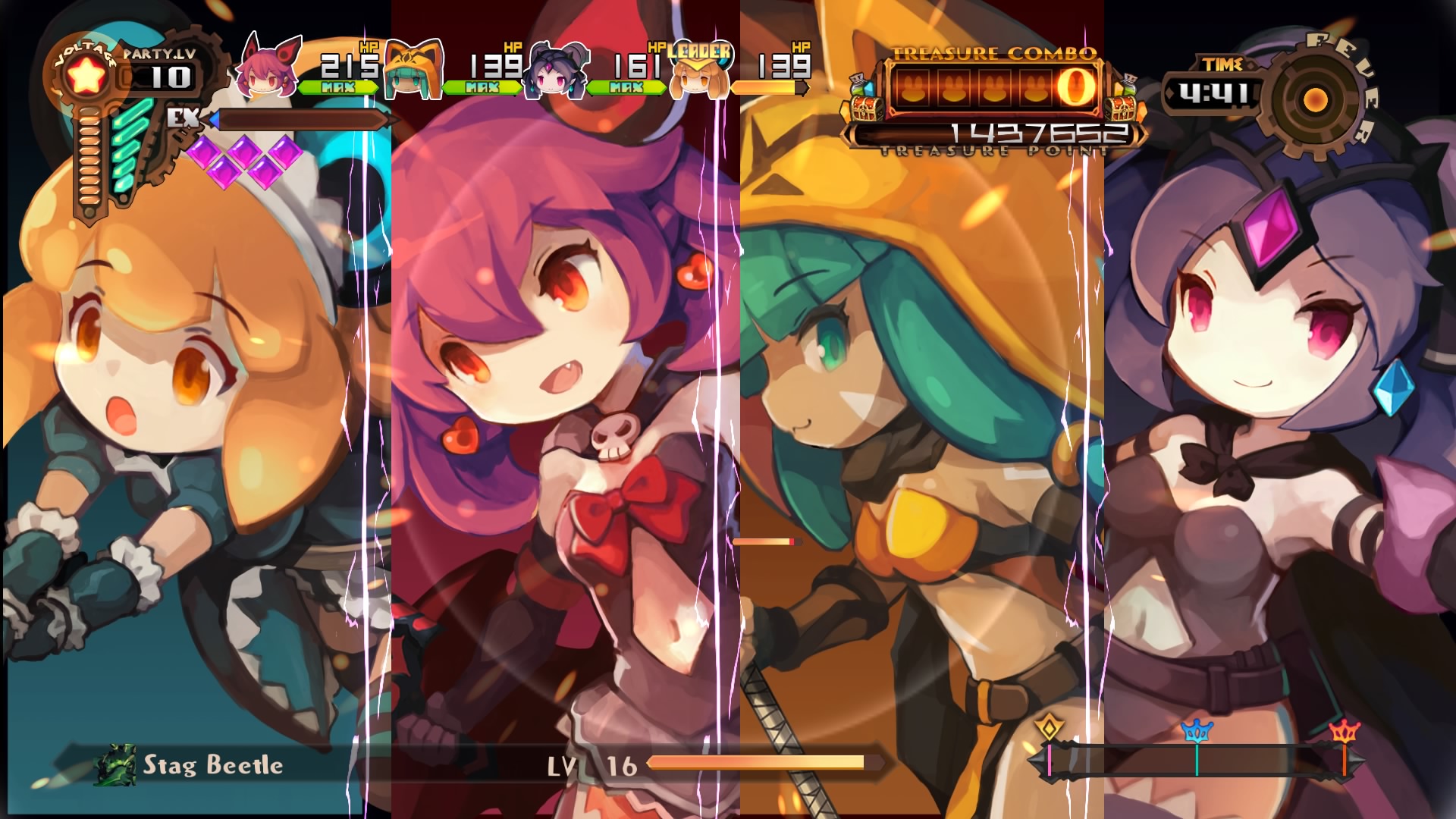Search
[{{{type}}}] {{{reason}}}
{{/data.error.root_cause}}{{{_source.title}}} {{#_source.showPrice}} {{{_source.displayPrice}}} {{/_source.showPrice}}
{{#_source.showLink}} {{/_source.showLink}} {{#_source.showDate}}{{{_source.displayDate}}}
{{/_source.showDate}}{{{_source.description}}}
{{#_source.additionalInfo}}{{#_source.additionalFields}} {{#title}} {{{label}}}: {{{title}}} {{/title}} {{/_source.additionalFields}}
{{/_source.additionalInfo}}- Details
- Category: PlayStation 4
- By Sam George
- Hits: 4267
Lapis x Labyrinth (PS4)

Lapis x Labyrinth
Developed by: Nippon Ichi Software, Inc.
Published by: NIS America, Inc.
Release date: May 28, 2019
Available on: PlayStation 4, Nintendo Switch
Genre: RPG Platformer
Number of players: Single player
ESRB Rating: E10+ for Fantasy Violence
Price: $29.99
(Amazon Affiliate Link)
Thank you, NIS America, for sending us a review key!
Lapis x Labyrinth surprised me several times. An anglerfish dragon was shockingly deadly, as were poisonous trap plants. A fire boss required careful maneuvering, and the last boss forced me to rework my weapon loadout for elemental damage. I don’t take the distinct memories of these moments as a great commendation of the game. From moment to moment, the game demands doing the same actions all the way through, with upgrades to break up the monotony. And yet, Lapis x Labyrinth didn’t feel tedious. Whether that’s because it is fun or numbing, I’m not sure. Probably a bit of each.
On the one hand, it must have been fun. I completed the game’s ten worlds, each a collection of stages in the Labyrinth below a small town. I beat the final boss and looked into the extra, post-game stages. Once or twice I whooped at the screen upon beating a particularly difficult foe. The gameplay which I have and will continue to describe as monotonous was engaging while I was taking part in it. It’s satisfying to watch the small party of adventurers tear through enemies, hopping from spring to falling platform while swinging any number of weapons and tossing allies at enemies to do coordinated alternative attacks. The joy of watching the combat take place is probably Lapis x Labyrinth’s greatest strength. The party of up to four adventurers are stacked on top of each other’s shoulders. This odd tower of oversized heads tears through most enemies with ease as the player hits the two main attack buttons. Swiping monsters away continues to feel satisfying for the entire game.
Someone watching could easily (and did, while I was playing) describe the combat as button mashing. It’s an unfair description, because attacks and movement depend on directional input, and as the pile of adventurers darted and spun across the screen I felt completely in control. My chosen leader was a mobile dagger-wielder who could slash up for an extra jump and spin down through a cloud of enemies with ease. When I switched to a heavily-armored knight, I knew his heavy swings would wipe out monsters and blocks with an efficiency appropriate to his weightier movements. Enemy attacks can quickly kill the party, necessitating constant vigilance to dodge incoming attacks. Lapis x Labyrinth is, when it comes to character control, very good at conveying the information needed. For example, the stack of adventurers is also the double-jump count. The adventurers leap off of each others’ shoulders with their extra jumps, sometimes leaving the leader stranded without friends for a moment when reaching a new ledge. As characters are knocked off the tower, stunned, or killed, movement becomes more limited.

Strong Points: Charming and varied art style; variety of upgrade paths and character types; maze platforming can be rewarding and tense
Weak Points: Monotonous gameplay; gaudy particle effects and music; constant voice exclamations
Moral Warnings: Revealing clothes on some character models; ghost and demon enemies
“Labyrinth” isn’t just a name. Each of the 80 main stages is composed of roughly one to four levels plus a miniboss. The last stage in each world has a stronger boss tied to the thin lore of the area. The bosses are usually far too straightforward, but the stages themselves can provide a decent challenge. The party must collect a number of crystals in each level to warp to the next. There are more crystals available than are required to succeed, and collecting extra is rewarded with better equipment and stat growth. Each stage has a five-minute timer, after which a dark specter appears who causes instant death if he touches the party. Pushing your luck against the threat of death for crystals and treasure chests is a rush when the level layouts are always uncertain. Most stages take less than ten minutes, and the timer ensures that almost none take more than twenty. Level mazes and enemy types recycle, but there are enough that I could not memorize them.
There are more character classes than I needed. The game encourages the player to experiment early on to find a team composition that suits a preferred play style, and I quickly fell into a mobile melee composition. A defensive shield character did more for my group than a gunslinger or ranged caster. I found a use for the maid (who, of course, is magical) and her abilities to boost party attack and charm enemies into temporarily not fighting. The party must be outfitted with weapons, armor, and other stat-boosting gear. If you have the space left over, members can be given reusable candy that heals, revives, and otherwise helps the party between levels in a stage. The game’s gear costs limit the party’s power level harshly, and spending gold to equip more and stronger gear did not feel satisfying.
There is more customization available within the town above the labyrinth. Enhancements for countless special effects including extra attacks, shielding, reflection, life steal, and more can be crafted and improved at the forge. A restaurant sells single-use lunches next to the store which sells equipment, crafting materials, and base stat upgrades. Individual character’s stats can be trained as well. I focused on training to keep up with monster strength, and I can imagine someone else focusing on a variety of weapon enhancements that provide bonuses against the enemy types particular to each world.

Higher is better
(10/10 is perfect)
Game Score - 86%
Gameplay -13/20
Graphics - 7/10
Sound - 6/10
Stability - 5/5
Controls - 5/5
Morality Score - 86%
Violence - 8/10
Language - 10/10
Sexual Content - 8/10
Occult/Supernatural - 7/10
Cultural/Moral/Ethical - 10/10
So Lapis x Labyrinth has engaging customization, controls, and platforming. It’s just that I was performing the same actions with almost no variation for the entire game. As stated at the beginning, a few moments demanded that I mix up my strategy. Those were few and far between. Mostly I roared through levels on autopilot. The vast majority of the minibosses fell in under ten seconds to a combination attack plus a little manual slicing. Even the final stage of the last boss, after killing me until I brought a type-effective weapon, died in seconds, almost without me noticing, once I did. I thought I’d seen everything Lapis x Labyrinth had to offer after the second world, and aside from unlocking upgrade options and some devious traps, I was not wrong.
That I could go so long without mentioning the grating aesthetic choices is evidence of how numb they made me. The game’s only voice acting is short snippets of Japanese exclamations of the “Thanks” and “Here we go” variety. These lines play when talking to shopkeepers in town and constantly while in the Labyrinth. I was not bothered. Others might not overlook the constant cries so easily. The game’s powerup graphics have the subtlety of Pavlov running a penny-ante slot machine. When Fever mode is activated (and I honestly don’t know how it’s activated), the music kicks into generic swelling tones as boxes flash and killed enemies explode into gems. And I mean, a lot of gems. Gems that hide the action on-screen. Gems that don’t fit the art style. Gems that would look comfortable in the original Bejeweled. During Fever mode, a spinner in the corner flashes through icons, occasionally announcing that I have been granted a Map or a Potion. Each icon corresponds to a buff, but since I had no control of the spinner and little care in that moment for the numerical peculiarities of how enemy health bars disappeared, I never remembered what the buffs were. I got used to the jarring particles, just as I got used to the voice acting.
In general, the art style is pleasant and cute. Some characters have revealing outfits on their menu models. Fortunately, most of the game is spent in big-headed chibi style where it’s hard to notice the clothes. There are a wide variety of well-designed monsters. The demon and ghost enemies are, like the others, stylized past the point of great concern. Violence is omnipresent in the dungeons in the cute art style of everything else. Music is forgettable but appropriate when not in fever mode.
As I've gathered my thoughts, I’ve been struck by how positive I am about this game considering how pleased I was to be finished with it. It was so repetitive. The best parts of the game enabled me to get through the monotony faster and with more style. Cynically, one might say that is true of action games at their best. At least this action game has consistent and generous content, all digestible in short or long play sessions. For as much as I finished playing the game the same way that I began it, Lapis x Labyrinth has enough moving parts to make the long journey from world one to ten more exciting than it might feel in worlds two, three, four, five, six, seven, eight, nine, or, come to think of it, one and ten. If a screenshot of the four adventurers teetering on their companions’ shoulders looks amusing, I would not talk you out of trying the game out. If you have a Switch to play on the go, I might try to talk you into it.






